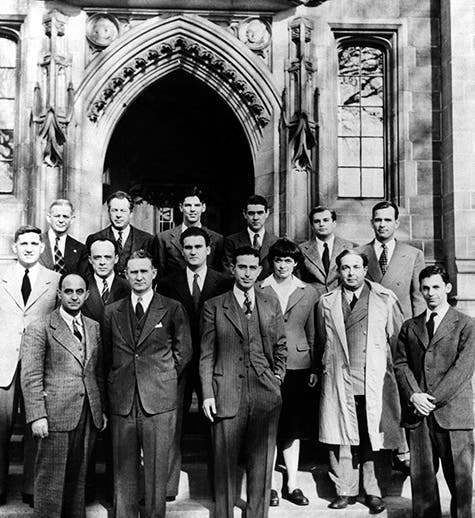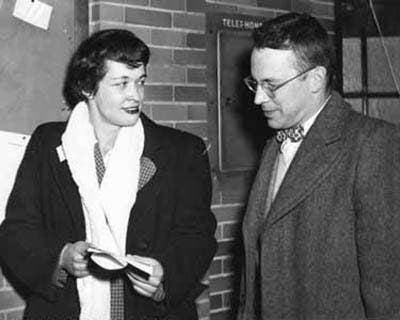Scientist of the Day - Leona Woods
Leona Woods, later known as Leona Woods Marshall and then as Leona Woods Marshall Libby, an American physicist, was born Aug. 9, 1919. Woods was at the University of Chicago in 1942, working on her PhD in physics, when, by her son's account, she ran across physicist John Marshall shaping graphite blocks in a hallway, and Woods correctly guessed that they were for an atomic pile. Indeed they were, but that was a top-secret enterprise at the time, so they had little choice but to let her into the project. She proved to be very good at nuclear physics. She was the only woman who worked on Enrico Fermi's Chicago Pile-1, or CP-1 for short, and the only woman present when the pile became self-sustaining on Dec. 2, 1942. There is a photograph of all the people who worked on Fermi's project, taken four years later, and it is not hard to spot Leona Woods (first image). There also survives a document, dated 1962, signed by all the people who were there when CP-1 went active, and you can spot her name at the top on the right (second image).
Woods and Marshall married in 1944 and went to work on the Hanford reactor in Washington, where they were making plutonium for the Manhattan Project. She reportedly played an important role in identifying the so-called "xenon poisoning" problem, where xenon gas was building up in the reactor, absorbing neutrons, and shutting it down. The problem was solved and plutonium production went forward.
Her work changed directions when she divorced Marshall and married Willard Libby in 1966. Libby already had a Nobel Prize, for inventing the radio-carbon dating system so important for archaeology. Leona Libby began to look at methods of reconstructing past climates, and predicting future ones, by studying the proportions of the two isotopes of oxygen, O16 and O18, in the carbon record, mostly in trees. It turns out that under different climate conditions, plants lock up different proportions of O16 and O18, and if you can date the wood samples independently, you can draw conclusions about temperatures at different times. Fortunately, dendrochronology, the calibration of tree rings, provided the time scale, and so it was possible to find the temperature at which a particular piece of wood formed at a certain time, by measuring the O16 and O18 levels. Woods called it tree thermometry. It proved to be a very useful climatological tool.
In her later years, Libby wrote several books that are not exactly popular science, but which are certainly accessible to educated readers, which her scientific papers would not be. One of these is Past Climates: Tree Thermometers, Commodities, and People (1983), a book whose opening chapter is a surprisingly good history of the discovery and application of isotopes in the 20h century, surprising because Libby was not a historian. Her other book, which we just acquired, is The Uranium People (1979), the story of her participation in the Manhattan Project.
Dr. William B. Ashworth, Jr., Consultant for the History of Science, Linda Hall Library and Associate Professor, Department of History, University of Missouri-Kansas City. Comments or corrections are welcome; please direct to ashworthw@umkc.edu.









![Columbine, hand-colored woodcut, [Gart der Gesundheit], printed by Peter Schoeffer, Mainz, chap. 162, 1485 (Linda Hall Library)](https://assets-us-01.kc-usercontent.com:443/9dd25524-761a-000d-d79f-86a5086d4774/3829b99e-a030-4a36-8bdd-27295454c30c/gart1.jpg?w=210&h=210&auto=format&fit=crop)
